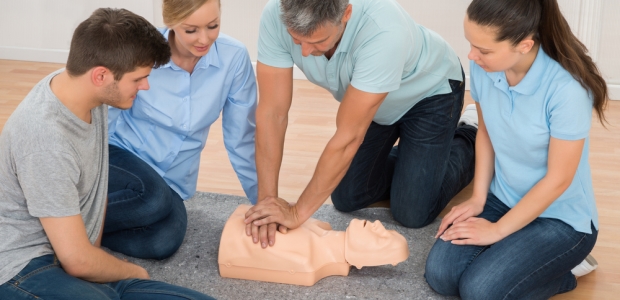
Most American Workers Unprepared for Workplace Cardiac Emergencies
"The data suggests these untrained employees may be relying on their untrained peers in the event of an emergency, leaving employees with a false sense of security that someone in the workplace will be qualified and able to respond, when that is clearly not the case," said Dr. Michael Kurz, M.D., co-chair of AHA's Systems of Care Subcommittee.
DENVER -- The American Heart Association is launching a new campaign that calls for training U.S. workers to respond appropriately to workplace cardiac emergencies and also for public access to AEDs, automated external defibrillators. The association announced it June 19 and released results from new surveys that indicate most American workers aren't prepared to handle these emergencies because they lack training in CPR and first aid.
Sharing the details of the research findings with attendees of the American Society of Safety Engineers' Safety 2017 conference and expo here, American Heart Association officials said they'll be publicizing the details widely during the second half of this year. More employee training on CPR and use of AEDs is clearly needed, the surveys show, and they also point out the need for more refresher training.
There are about 10,000 cardiac arrests annually in the nation's workplaces, according to AHA, the leading voluntary health organization devoted to fighting cardiovascular disease.
The surveys showed most workers do not have access to CPR and first aid training and half could not locate an AED at work. More than 3,000 workers in various fields were surveyed between February and April 2017, and 2,000 employees in corporate offices, hospitality, education, and industry/labor and more than 1,000 safety managers in industries regulated by OSHA also were surveyed. Key findings from the employee study commissioned by AHA and conducted by Edelman Intelligence include these:
- 55 percent of the respondents cannot get first aid or CPR and AED training from their employer – and even if employers do offer this training, it is often either one or the other.
- 50 percent of all U.S. workers can't locate the AED where they work; in the hospitality industry, this is true for 66 percent.
"The data suggests these untrained employees may be relying on their untrained peers in the event of an emergency, leaving employees with a false sense of security that someone in the workplace will be qualified and able to respond, when that is clearly not the case," said Dr. Michael Kurz, M.D., co-chair of AHA's Systems of Care Subcommittee and associate professor at the University of Alabama at Birmingham School of Medicine in the Department of Emergency Medicine.
The surveyed safety managers in OSHA-regulated industries agreed more frequent training is needed, although one-third of them said first aid, CPR, and AED training became important and offered only after an incident demonstrated the need. Other findings from the OSHA survey, commissioned by AHA and fielded by EHS Daily Advisor, include these:
- 33 percent of safety managers said lives have been saved at home and at the workplace as a result of first aid, CPR, and AED training provided at work and 75 percent said injuries or medical conditions have been treated in the workplace with this training.
- 36 percent felt it would be valuable to offer training more frequently than every two years (the current requirement).
- Younger generations at OSHA-regulated industries were less likely to participate in first aid, CPR, and AED training, although the numbers are still high at more than 44.5 percent.
"This could be due to a decreased sense of risk among younger workers," said Peter Fromm, MPH, RN, co-chair of the AHA Emergency Cardiac Care Subcommittee on Systems of Care and administrator at the South Nassau Communities Hospital Center for Cardiovascular Health. "We are disheartened that lifesaving first aid and CPR+AED training is often only offered after a serious incident that demonstrated need," he added. "All businesses should be committed to proactively fostering a safe workplace environment, one that empowers people to take on a small social responsibility that can have a large community impact."
"First aid, CPR, and AED training need to become part of a larger culture of safety within workplaces," said Kurz. "We are certainly seeing higher public interest in this training, and our campaign calls upon decision makers in workplaces and popular public spaces such as arenas, fitness centers, hotels, and churches to place AEDs in the same locations as a fire extinguisher."
For more information on The Workplace Safety Training Initiative and the study findings supporting the new campaign, visit the AHA's workplace training site (heart.org/workforcetraining).